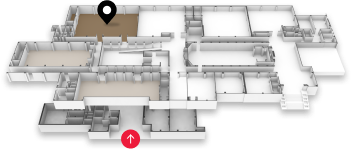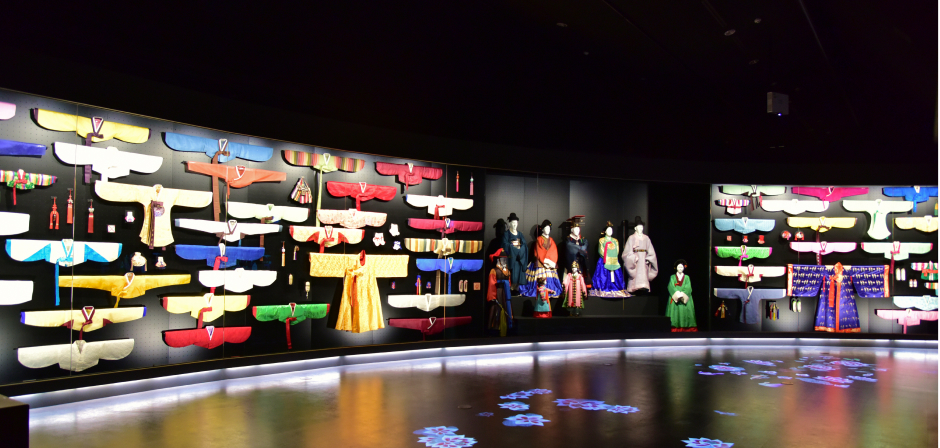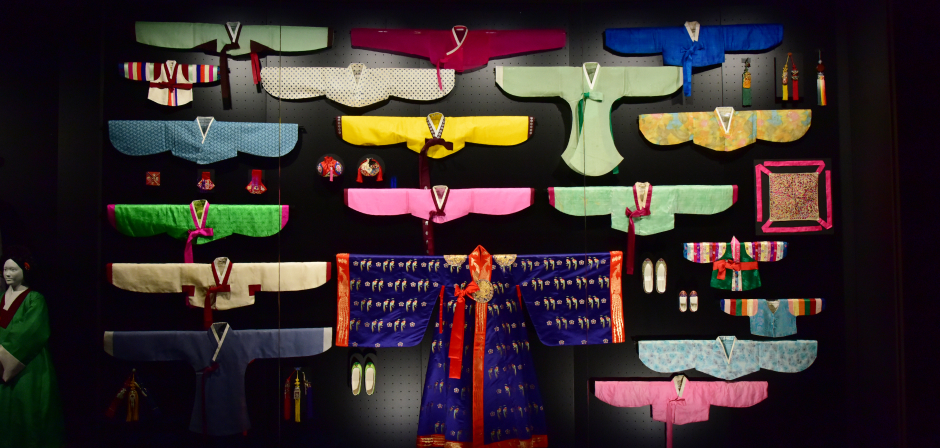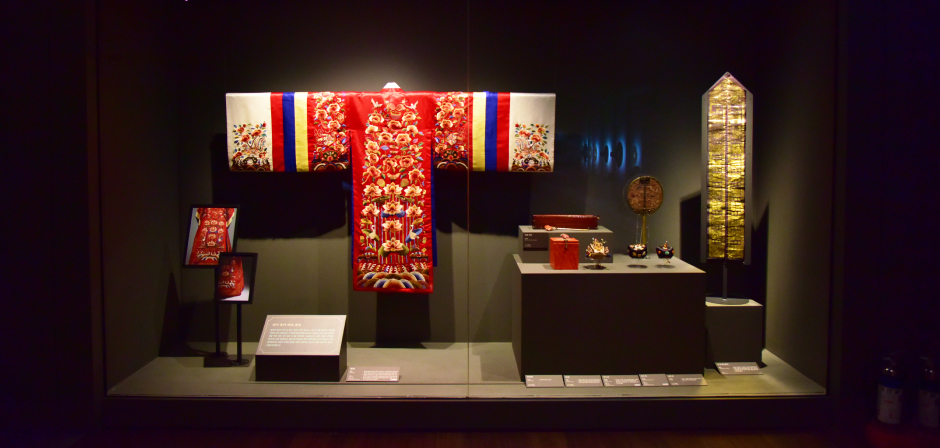This gallery uses artifacts and records to relate the history of clothing, which occupies a major place in all of our lives, from ancient to modern times. It focuses on Daegu, a city where the textile and clothing industry contributed greatly to its development into a modern city. Visitors are invited to enjoy the beauty and richness of hanbok (Korean traditional outfits) including headdresses, shoes, ceremonial attire, and embroidery that have been passed down through the generations.
Duration
Ⅰ. Hanbok: Past, Present, and Future
The first section, “Hanbok: Past, Present, and Future,” showcases the beauty and color of hanbok,
spotlighting jackets, skirts, shoes, beads and embroidery. The video “A Promenade through Hwarot”
displays the harmony between the embroidered patterns of hwarot (a type of women’s ceremonial robe)
and sounds of nature such as water and flowers. It offers an opportunity to experience the beauty of
hanbok in a multi-dimensional manner.
Ⅱ. Hanbok: From Head to Toe
The second section, entitled “Hanbok: From Head to Toe,” presents a wide range of waistbands,
ceremonial dresses, and headdresses, including gat (headgear with a brim), elements of hanbok that
were especially popular from the 1940s to the 1980s. It also explores elements borrowed from Western
clothing that can be found in the hanbok produced during this period. Visitors can explore the
designs and overall significance of hanbok, an iconic symbol of Korean identity.
Ⅲ. Decorative Patterns: The Beauty of the Times
“Decorative Patterns: The Beauty of the Times,” the third section, presents thematic exhibitions
exploring traditional textiles and patterns in greater depth. The first thematic exhibition within
the section spotlights jikgeum, patterns woven into silk fabric using gold thread. It displays a
jeogori (jacket) decorated using the jikgeum technique that was discovered in Yeongdeok-dong in
Yongin, Gyeonggi-do Province. The jacket is being shown to the public for the first-time following
its restoration. It was recovered in 2005 from an unidentified Joseon-era tomb situated within a
residential land development district in Yeongdeok-dong. Fifty-two pieces of clothing were
discovered in the tomb, including the jacket decorated with jikgeum. The jacket is an important
artifact that provides an understanding of the clothing culture of the early sixteenth century,
particularly textiles and patterns.
Ⅳ. MODAM, The Carpets of Joseon Dynasty
The fourth section introduces modam. A modam is a Joseon-era carpet woven from wool and cotton
threads. Many different types of woolen textiles were produced from the Three Kingdoms period
through the Joseon Dynasty, including tapdeung, guyu, gyedam, mojeon, chaedam, and hwadam. However,
there are only a very few surviving examples of modam, which is why the term might be unfamiliar to
many of us today. The Daegu National Museum will continue to strive to introduce a wide range of
traditional Korean textiles and patterns.
Featured Items
Men’s Horsehair Hat & White Mourning Hat Early 20th Century
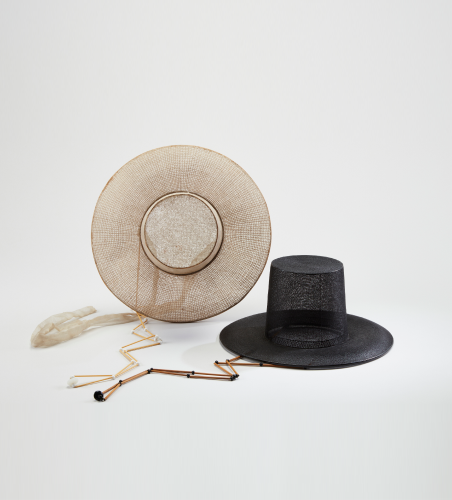
Black horsehair hats were the most common type of men’s brimmed hat (gat) during the Joseon Dynasty, but the height of the crown and width of the brim varied over time. Gat grew increasingly larger during the sixteenth and seventeenth centuries until they had become so tall and wide by the eighteenth century that they provided an obstacle to passing through doors. Following a clothing reform imposed in 1884 (the 21st year of the reign of Emperor Gojong), brimmed hats grew smaller. White hats were worn as part of the formal mourning outfit known as sangbok. They are identical in composition and form to black versions, but the basic frame of bamboo or horsehair is wrapped with white cloth.
Fluttering Hairpins
Late Joseon Dynasty

These are hair ornaments worn by women during the Joseon Dynasty. They were pinned at the center and sides of the keunmeori hairstyle (characterized by braided hair wound up and affixed on the top of the head) worn to accompany a ceremonial outfit.
Men’s Headband Buttons
Joseon Dynasty

These small button-like rings were attached to the sides of a headband (manggeon). A string tied around the head would be threaded through them. In addition to their practical function, they indicated the wearer’s social status through their different materials and decorative carvings.
Jade Finial of Men’s Hat
Joseon Dynasty

This jade ornament in the shape of a heron was used to adorn the top of a gat (men’s brimmed hat).
Jacket with Floral Scroll Design, Silk Satin Damask
1940s
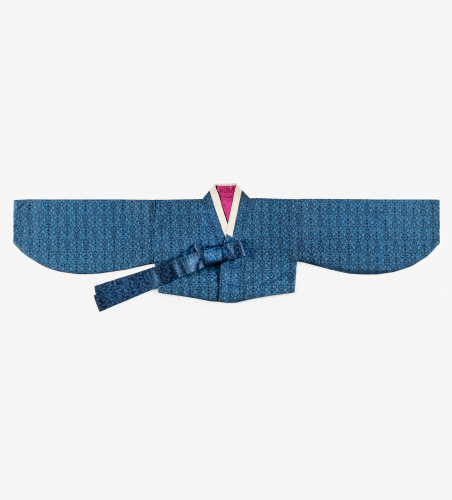
This is a woman’s winter jeogori (jacket) made of silk satin damask and lined with cotton. The type of fabric used for the outer shell was based on silk imported from Europe in the 1900s. Silk satin was favored for its subtle patterns and soft luster, making it a luxurious fabric.
Jacket with Floral Patterns
1940s
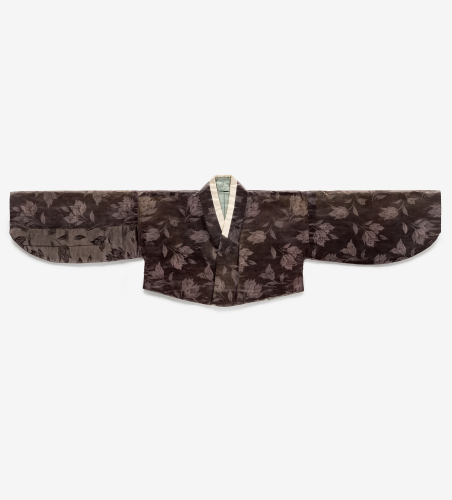
This is a woman’s jeogori (jacket) characterized by a floral-patterned satin damask outer shell and a lining made of fabric typically used for Western-style women’s clothing. It does not have goreum (fastening ribbons) and was designed to be fastened with a brooch.
Bridal Robe 20th Century
Lee Young-Hee Collection

A hwarot is a form of garment that was worn as a bridal gown by princesses or women of the upper class during the Joseon Dynasty. However, they were eventually allowed to be worn as bridal gowns by women of the commoner class. The exterior of these garments was exquisitely embroidered with various designs symbolizing longevity, good fortune, and fertility, including waves, rocks, peonies, and butterflies.
Women’s Semi-Formal Jacket 20th Century
Lee Young-Hee Collection
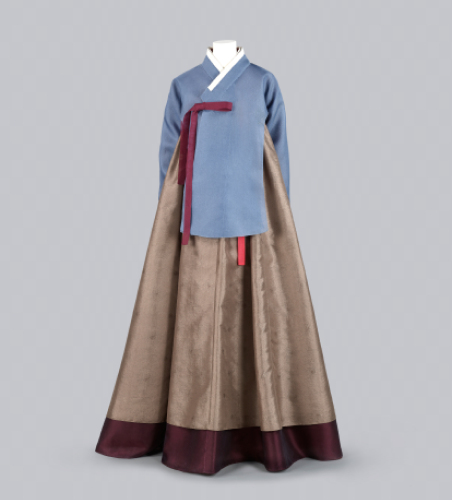
This is a type of ceremonial garment that was worn over a jeogori (jacket) by women during the Joseon Dynasty. They were worn at the royal court for ritual or festive occasions, both major and minor. Court attendants or women from the commoner class also wore this type of garment, but their versions were characterized by different materials and decorations.
Carpet with Five Crane, Flower and Plant Design 19th Century

A crane in the center surrounded by four other cranes, bonghwang (mythical birds), small birds, and flowers are expressed subtly across this carpet. The edges of the four corners are decorated with designs of clouds and bats. The upper and lower stripes and cranes were woven with thread while the other designs were painted using a brush.
Carpet with Phoenix and Peony Design
18th Century
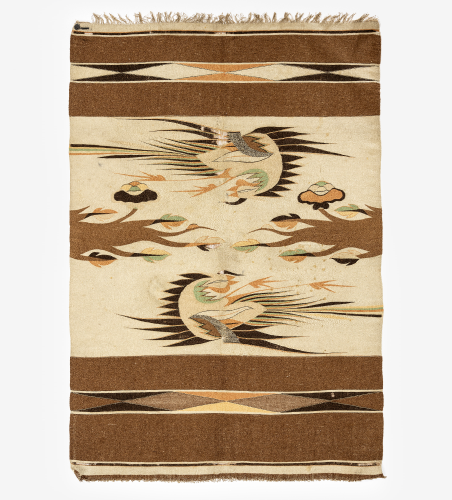
This carpet features a pair of mythical birds and peonies arranged in a symmetrical manner. The upper and lower parts are decorated with a band comprised of rhombus shapes. The symmetry of the birds and peonies lends a sense of calm and stability.
Long Jacket Made of Gold Thread-woven Fabric Decorated with Cloud and Bird Design Joseon, Early 16th Century, Replica

Other than its sleeves, this jeogori (jacket) is decorated using jikgeum, a technique involving weaving patterns in gold thread. The exquisite designs and the long slits on the sides of the jacket suggest that it was a ceremonial garment. The patterns are comprised of two birds surrounded by clouds with their necks intertwined and wings spread wide.
Princess Cheongyeon’s Long Jacket Made of Gold Thread-woven Fabric Joseon Dynasty Mid-18th–Early 19th century
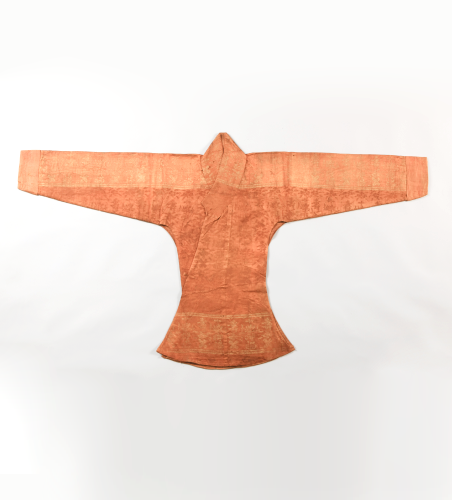
This is a four-ply ceremonial garment made of two layers of jackets that are partially stitched together. The shoulders, sleeves, and panel attached to the center front of the bodice are decorated with designs woven in gold thread. The outer shell features designs inspired by the Chinese characters ‘壽’ (longevity) and ‘福’ (good fortune) along with pomegranates, flowers, and treasures.
